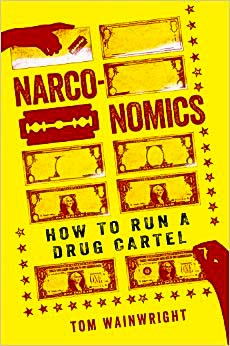
c/o amazon.com
Did you know that in 2011, in the Mexican border town of Juárez, one drug cartel bought out the state police while another bought out the federal police, and that the cartels held so much power over both that you could find the two sets of law enforcement engaging in shootouts for cartel territory? Did you know that the first-ever online purchase in 1971 was for a dime bag of marijuana? Did you know that, despite the view that cartels are chaotic, nihilistic, and unpredictable, they function much in the same way as big businesses like Walmart and McDonald’s?
As you read Tom Wainwright’s new book, “Narconomics,” these facts and arguments pop out at you in unexpected ways. Wainwright, a journalist for The Economist since 2010, dives into the world of the drug trade in his debut work, traveling from Peruvian Andes to New Zealander nightclubs and Colorado head shops. In covering all corners of the globe, he seeks to reveal how this world is both familiar and foreign to us—how, on the one hand, cartels and illegal drug agencies engage in violence and corruption in ways seemingly unheard of in U.S. society; and how, on the other hand, the drug business is similar to any other business, governed by certain fundamental laws of economics. At the basic level, Wainwright wants to show us how the drug world works and, consequently, how we may be able to regulate and control it.
It has become increasingly clear that the war on drugs has been a failure. President Obama has come out and said that U.S. drug policies have been “unproductive,” and the seemingly unstoppable cartels attest to this fact. Even with supposed successes like the recent arrest of El Chapo—or Shorty, as he is affectionately called—cartels still have a powerful grip on Mexican society. When El Chapo was arrested for the first time in 2014, for example, thousands of citizens in the state of Sinaloa came out to march in honor, with shirts that said “Shorty is more loved and respected than many politicians!” and, “Shorty, make me a baby.” While capturing kingpins and running raids may seem to help on the surface, they fail to get to the root of the problem, and as Wainwright argues, fail to understand how these businesses actually function on a day-to-day basis.
To show how these businesses work, Wainwright uses frequent comparisons to the corporate businesses that are familiar to U.S. readers. In one brilliant passage, he explains why the price of cocaine has stayed the same for the past two decades, despite all the millions of dollars put into lowering the supply to raise the price and thus decrease usage.
“To understand how [cartels] have pulled off this trick,” he writes, “Consider Walmart, which has sometimes seemed able to defy the laws of supply and demand in a similar way to the drug cartels.” While everyone knows the concept of a monopoly, where one company is the dominant supplier for a product and can thus charge however much they want, Walmart and cocaine cartels work as “monopsonies—that is, dominant buyers of certain products.” Just as Walmart can make clothing manufacturers latch onto their company by offering them the best deal for their product, cartels can make poor farmers latch onto their business by offering them the best deal for their labor, which consequently goes toward harvesting the plant central to the cocaine business—i.e., coca.
Wainwright concludes: “It is tempting to imagine that the whole cocaine business is in the hands of the cartel from start to finish, with gun-toting mobsters lovingly tending their coca bushes with Baby Bio in between massacring their rivals. But that isn’t usually how it works. The agricultural side of the cocaine industry is mostly handled by ordinary farmers like the ones in Trinidad Pampa [in Bolivia], who would just as happily grow tomatoes or bananas if they paid as well as coca.”
Is it possible that we could destabilize the cocaine trade by somehow giving farmers something else that they could do? That is, could the Bolivian government somehow make it more profitable to grow tomatoes or bananas rather than coca, so that farmers no longer have to be tied to an illegal business that kills over 300,000 people a year? Why have we not seriously given thought to this?
Politicians and lawmakers have always been keen on the idea that we must engage in a kind of violent battle to solve the problem of the illegal drug industry. They consistently believe that the only way to stop a kingpin from chopping off someone’s head is to shoot him in the head before he does it. In “Narconomics,” Wainwright bashes this method.
It seems that in a haze of arrogance and fear, the U.S. has forgotten that knowledge is power, that the old cliché of keeping your enemies closer than your friends may turn out to be true. Wainwright implies that if we know more about the inner workings of globalized cartels, we may be able to do something about them.
The main goal of “Narconomics,” then, is to inform, and by informing, also wriggle a way out of the drug war’s narrow-minded policies. The drug business is often weird, scary, and unbelievably violent. Wainwright’s book depicts this world we’re already vaguely aware of and shows what’s underneath—how, at its roots, the illegal drug industry is more familiar-looking than we tend to imagine. Before we can beat cartels, we must first understand them. Wainwright is leading us in the right direction.
Comments are closed